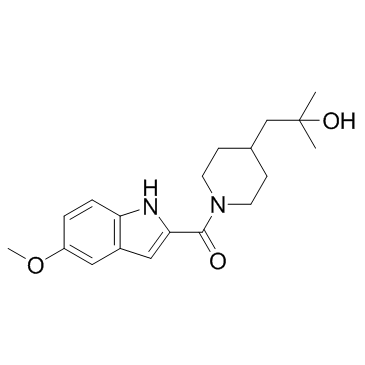1126084-37-4
| Name | 1-{1-[(5-methoxy-1H-indol-2-yl)carbonyl]piperidin-4-yl}-2-methylpropan-2-ol |
|---|---|
| Synonyms |
asp9521
[4-(2-Hydroxy-2-methylpropyl)-1-piperidinyl](5-methoxy-1H-indol-2-yl)methanone Methanone, [4-(2-hydroxy-2-methylpropyl)-1-piperidinyl](5-methoxy-1H-indol-2-yl)- ASP-9521 |
| Description | ASP-9521 is a potent, selective and orally available AKR1C3 inhibitor with an IC50 of 11 nM for human AKR1C3. |
|---|---|
| Related Catalog | |
| Target |
IC50:11 nM (human AKR1C3), 49 nM (monkey AKR1C3)[1] |
| In Vitro | AKR1C3 is a promising therapeutic target in castrationresistant prostate cancer, as combination of an AKR1C3 inhibitor and a gonadotropin-releasing hormone analogue may lead to complete androgen blockade.ASP-9521 inhibits conversion of androstenedione (AD) into androstenediol and testosterone (T) by recombinant human or cynomolgus monkey AKR1C3 in a concentrationdependent manner (IC50, human: 11 nM; IC50,monkey: 49 nM). ASP-9521 shows more than 100-fold selectivity for AKR1C3 over the isoform AKR1C2. In LNCaP-AKR1C3 cells, ASP-9521 suppresses AD-dependent PSA production and cell proliferation[1]. |
| In Vivo | In CWR22R xenografts, single oral administration of ASP-9521 (3 mg/kg) inhibits AD-induced intratumoural T production and this inhibitory effect is maintained for 24 h. After oral administration, ASP-9521is rapidly eliminated from plasma, while its intratumoural concentration remained high. The bioavailability of ASP-9521 after oral administration (1 mg/kg) is 35 %, 78 % and 58 % in rats, dogs and monkeys, respectively[1]. |
| Cell Assay | LNCaP-AKR1C3 cells stably expressing human AKR1C3 are seeded in 96-well plates at 10000 cells/100 μL/well in RPMI-1640 medium supplemented with heat-inactivated charcoal-dextran-stripped FBS (1 % for the PSA expression assay and T measurement and 5 % for the cell proliferation assay). After 24 h incubation, AD is added to each well with or without ASP-9521 (0.3-100 nM). The cell culture media are collected 24 h after administration of AD to measure T concentration and 6 days after administration of AD to measure cell proliferation using Cell-Titer Glo assay[1]. |
| Animal Admin | Mice carrying HEK293 or HEK293-AKR1C3 tumours with similar sizes are selected and randomly divided into 5 groups (N=3 for each group). All groups are treated with ASP-9521 (single oral administration; 3 mg/kg). Plasma (from the central vein) and tumour tissues are collected at 0.25, 0.5, 1, 2 and 4 h after administration of ASP-9521, and ASP-9521 concentrations are determined using the HPLCMS/MS method[1]. |
| References |
| Density | 1.2±0.1 g/cm3 |
|---|---|
| Boiling Point | 543.9±30.0 °C at 760 mmHg |
| Molecular Formula | C19H26N2O3 |
| Molecular Weight | 330.421 |
| Flash Point | 282.7±24.6 °C |
| Exact Mass | 330.194336 |
| PSA | 65.56000 |
| LogP | 0.62 |
| Appearance | white solid |
| Vapour Pressure | 0.0±1.5 mmHg at 25°C |
| Index of Refraction | 1.599 |
| Storage condition | -20℃ |
